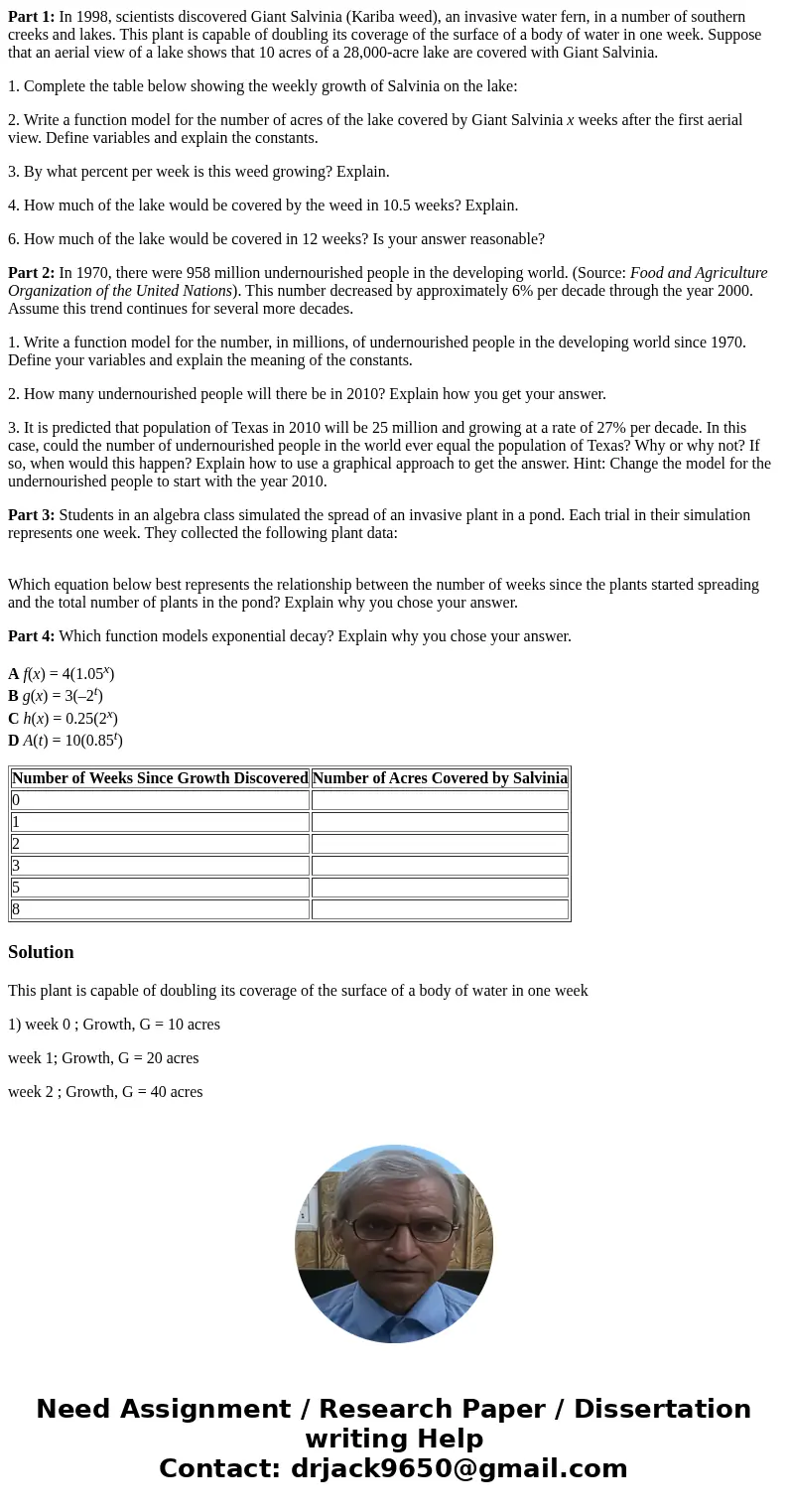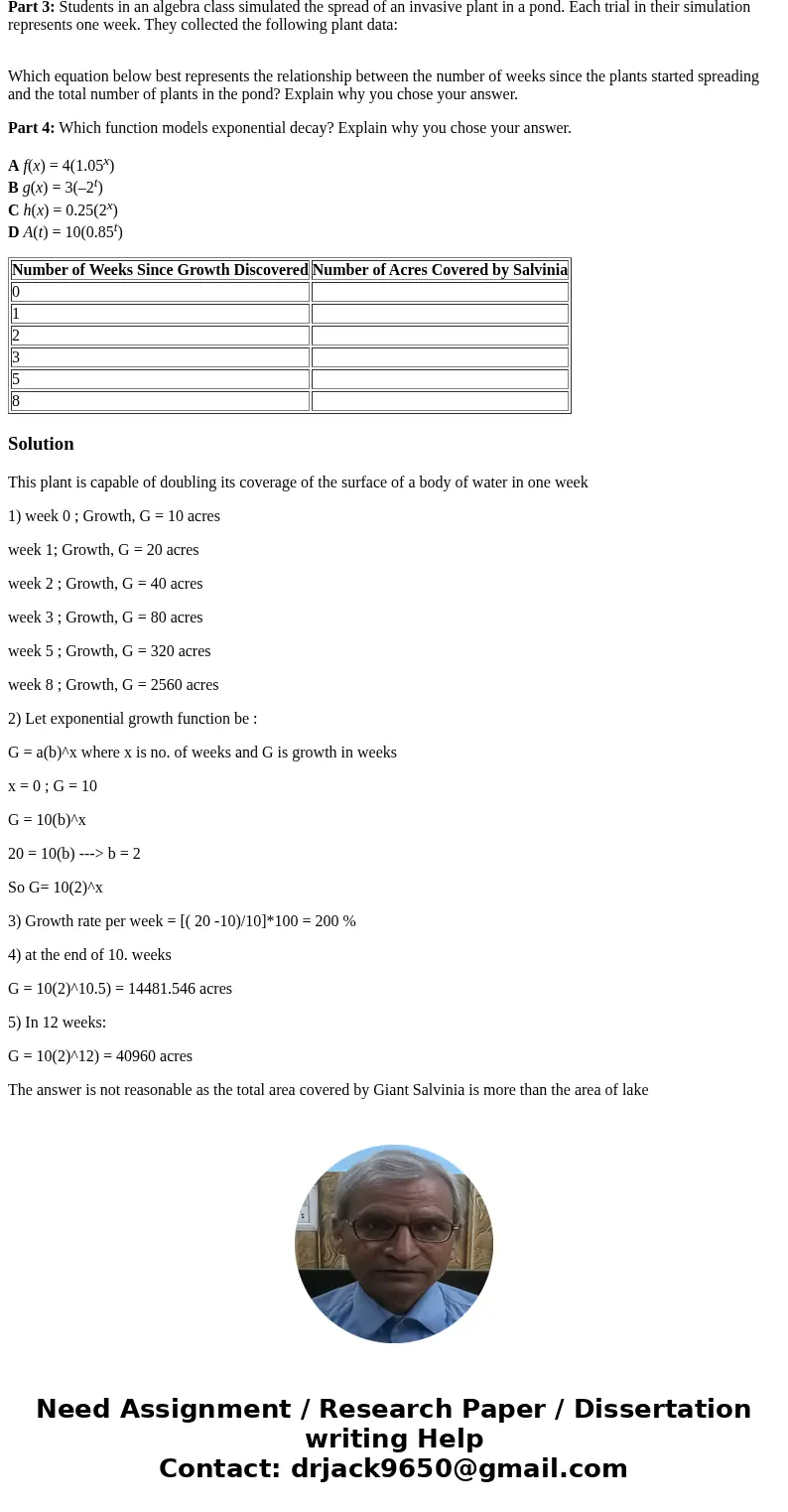Part 1 In 1998 scientists discovered Giant Salvinia Kariba w
Part 1: In 1998, scientists discovered Giant Salvinia (Kariba weed), an invasive water fern, in a number of southern creeks and lakes. This plant is capable of doubling its coverage of the surface of a body of water in one week. Suppose that an aerial view of a lake shows that 10 acres of a 28,000-acre lake are covered with Giant Salvinia.
1. Complete the table below showing the weekly growth of Salvinia on the lake:
2. Write a function model for the number of acres of the lake covered by Giant Salvinia x weeks after the first aerial view. Define variables and explain the constants.
3. By what percent per week is this weed growing? Explain.
4. How much of the lake would be covered by the weed in 10.5 weeks? Explain.
6. How much of the lake would be covered in 12 weeks? Is your answer reasonable?
Part 2: In 1970, there were 958 million undernourished people in the developing world. (Source: Food and Agriculture Organization of the United Nations). This number decreased by approximately 6% per decade through the year 2000. Assume this trend continues for several more decades.
1. Write a function model for the number, in millions, of undernourished people in the developing world since 1970. Define your variables and explain the meaning of the constants.
2. How many undernourished people will there be in 2010? Explain how you get your answer.
3. It is predicted that population of Texas in 2010 will be 25 million and growing at a rate of 27% per decade. In this case, could the number of undernourished people in the world ever equal the population of Texas? Why or why not? If so, when would this happen? Explain how to use a graphical approach to get the answer. Hint: Change the model for the undernourished people to start with the year 2010.
Part 3: Students in an algebra class simulated the spread of an invasive plant in a pond. Each trial in their simulation represents one week. They collected the following plant data:
Which equation below best represents the relationship between the number of weeks since the plants started spreading and the total number of plants in the pond? Explain why you chose your answer.
Part 4: Which function models exponential decay? Explain why you chose your answer.
A f(x) = 4(1.05x)
B g(x) = 3(–2t)
C h(x) = 0.25(2x)
D A(t) = 10(0.85t)
| Number of Weeks Since Growth Discovered | Number of Acres Covered by Salvinia |
|---|---|
| 0 | |
| 1 | |
| 2 | |
| 3 | |
| 5 | |
| 8 |
Solution
This plant is capable of doubling its coverage of the surface of a body of water in one week
1) week 0 ; Growth, G = 10 acres
week 1; Growth, G = 20 acres
week 2 ; Growth, G = 40 acres
week 3 ; Growth, G = 80 acres
week 5 ; Growth, G = 320 acres
week 8 ; Growth, G = 2560 acres
2) Let exponential growth function be :
G = a(b)^x where x is no. of weeks and G is growth in weeks
x = 0 ; G = 10
G = 10(b)^x
20 = 10(b) ---> b = 2
So G= 10(2)^x
3) Growth rate per week = [( 20 -10)/10]*100 = 200 %
4) at the end of 10. weeks
G = 10(2)^10.5) = 14481.546 acres
5) In 12 weeks:
G = 10(2)^12) = 40960 acres
The answer is not reasonable as the total area covered by Giant Salvinia is more than the area of lake


 Homework Sourse
Homework Sourse